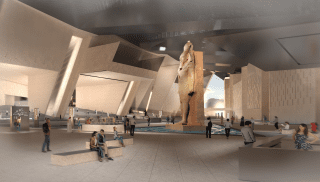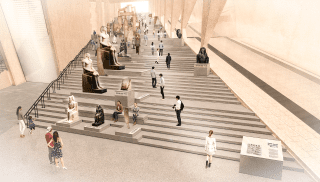GEM - Grand Egyptian Museum Gizeh
Project info
The Grand Egyptian Museum is currently under construction next to the pyramids in Giza and will be the largest archaeological museum in the world dedicated to a single culture, ancient Egypt. The museum is expected to boost cultural tourism in the country. It is expected to open at the end of 2018. Egyptian art and culture will be presented in a way never seen before. With more than 50,000 exhibits regarding the history of Ancient Egypt. Among them is the legendary burial treasure of the child pharaoh Tutankhamun, which will display its approx. 5600 pieces for the first time. The Tutankhamun collection is the star of the museum and will have an outstanding spot in the Tut Gallery, which will feature a walk through a 1:1 model of the Valley of The King's burial chamber - with original exhibits, accompanied by an elaborate media installation. Visitors will be taken on a journey, 3500 years back to the 18 Dynasty, to become discoverers of Tutankhamun's tomb. There you can see how the king dressed, what he ate, what his jewelry looked like, his chariots, and his furniture. Modern multimedia guides explain why these artifacts and objects were in his tomb. With the support of multimedia, up to 15000 people can accompany the pharaoh into the afterlife. The artworks come from museums and collections from all over Egypt, many have not yet been shown publicly. An 11-meter-high stone statue of Ramses II will also be on display. Approximately 90 large sculptures of the ancient Egyptian kings, which will be arranged chronologically, will be further explained using media stations. Visitors walk through a carefully narrated story, bringing the exhibits to life and perceiving them not only as art objects. The higher you walk, the closer you get to the pyramids. Once you reach the top, you can see them towering behind the glass façade.
Museum
Grand Egyptian Museum
Ausstellungsgestalter
ATELIER BRÜCKNER
exhibition type
Permanent
Our Tasks
2av gestaltet zusammen mit Atelier Bruckner die Stenografie der vier wesentlichen Ausstellungsbereiche Atrium, Grand Staircase, Tut Galerie und Kindermuseum. Die größte Herausforderung ist für die mitunter sehr kleinen Exponate ein entsprechendes Ambiente zu schaffen in Räumen mit gigantischen Ausmaßen, die bis zu 17 Meter hoch und 200 Meter lang sind. Es gibt keine chronologische sondern eine thematische Ordnung. 2av hat versucht multimedial eine Lesbarkeit der Exponate zu ermöglichen z.B. dank Vitrinen mit sensitiven Gläsern: berührt man die Scheibe, werden beispielsweise Hieroglyphen übersetzt. Und an Scan-Tischen werden die neuesten Erkenntnisse aus medizinische Untersuchungen vermittelt. Besucher sollen auf Entdeckungsreise gehen und Überraschungen erleben.

